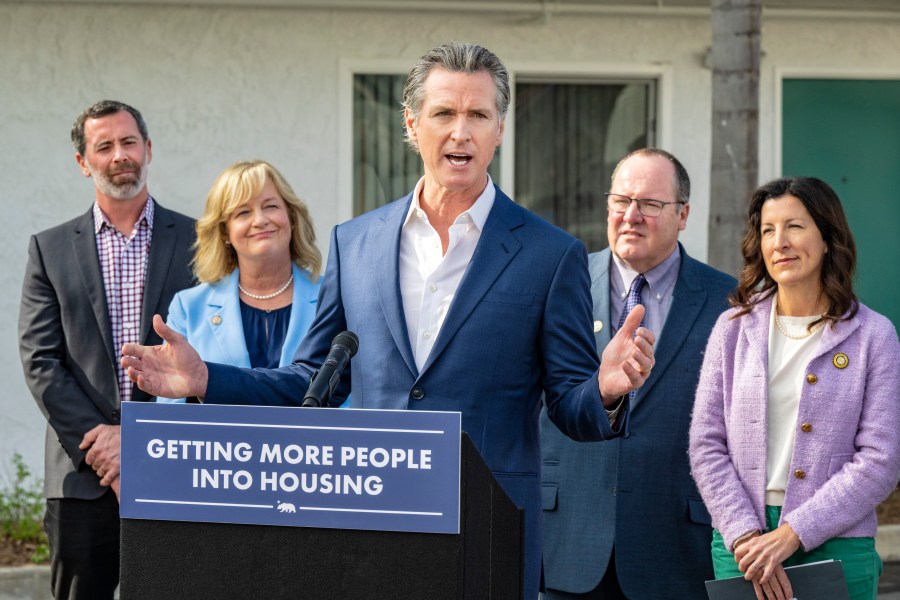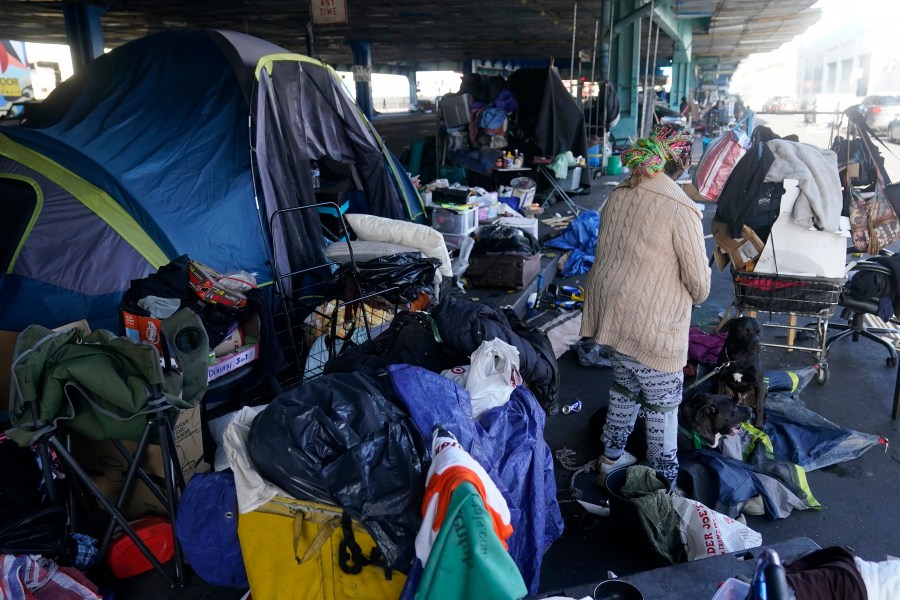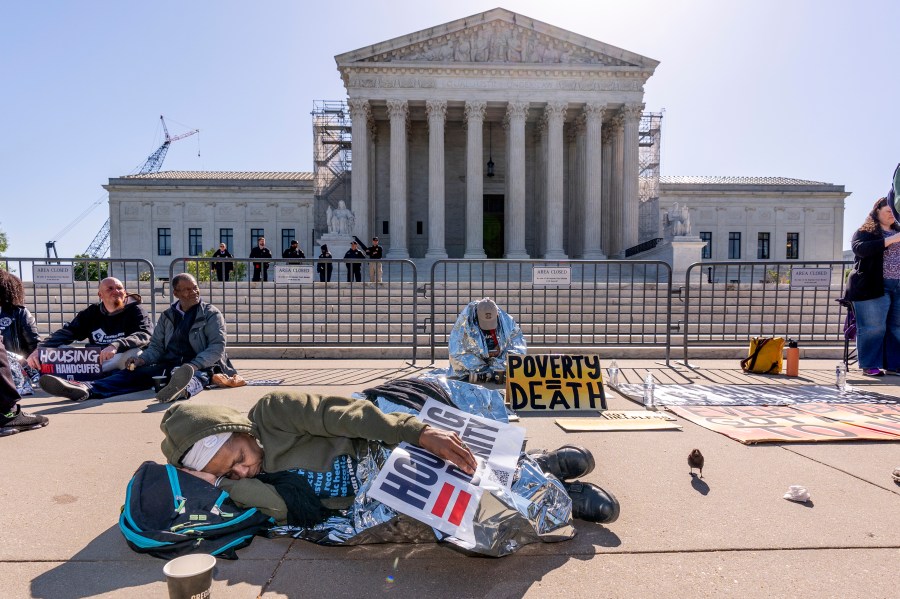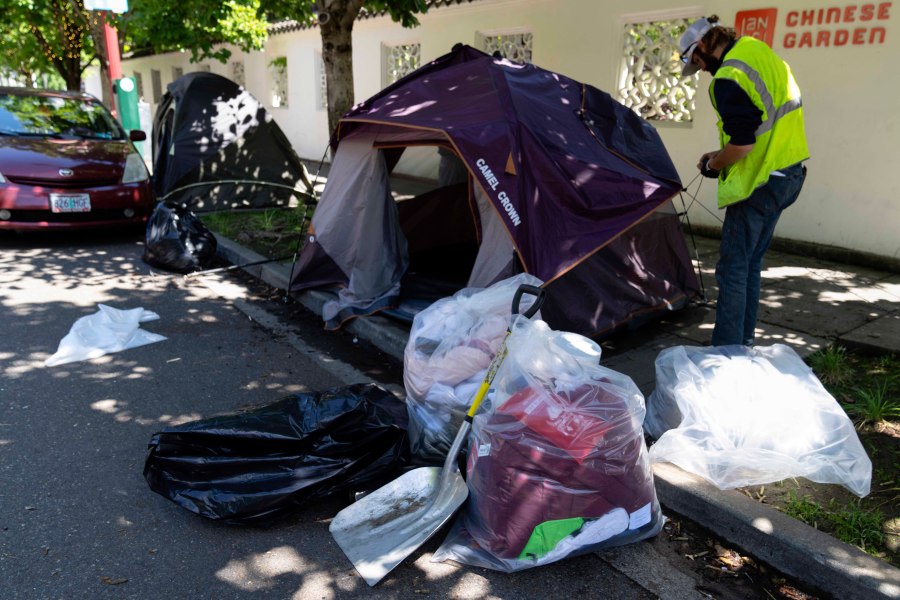Calif. Gov. Newsom wants homeless encampments cleared. Now what?
- Gavin Newsom ordered state agencies to begin clearing homeless encampments
- Proponents say the camps pose a safety issue and drive away business
- Critics say it won't solve the underlying problems fueling homelessness

FILE – Homeless encampments block the street on an overpass of the Hollywood freeway in Los Angeles, in July 7, 2021. The Los Angeles City Council has voted to ban homeless encampments within 500 feet of schools and daycare centers. The council voted Tuesday, Aug. 9, 2022 to broaden an existing ban on sleeping or camping near the facilities. (AP Photo/Damian Dovarganes, File)
(NewsNation) — California’s attempt to address homeless encampments on state land has sparked a debate about compassion, safety and resources.
California Gov. Gavin Newsom ordered state agencies Thursday to begin clearing out homeless encampments on state land, following a U.S. Supreme Court ruling allowing cities to enforce bans on sleeping outside in public.
The Supreme Court’s June decision reversed a ruling from a California-based appeals court that found such laws amount to cruel and unusual punishment, given shelter space limitations. However, California’s Democratic governor said the decision gave state and local officials the authority to clear “unsafe encampments” from the streets while acting with compassion.
“There are simply no more excuses,” Newsom said in a statement Thursday. “It’s time for everyone to do their part.”

How are people responding?
Business owners and politicians, including Sacramento Mayor Darrell Steinberg, say the order emphasizes compassion and safety while falling in step with some cities’ existing practices.
“I don’t believe people should be living in squalor in these large tent encampments,” Steinberg told local NBC affiliate KCRA. “Compassionate enforcement and aggressively increasing capacity on the shelter side, on the services side and on the housing side, is the key.”
Others, including a Los Angeles homeless outreach organization and the L.A. County Public Defenders Union, say clearing encampments will do more harm.
“Prioritizing clearing encampments takes money away from compassionate street level services, housing, and medical care, instead funding policing and criminalization strategies that we know will fail because we’ve tried them over and over again for decades,” the homeless outreach group KTown for All posted on X.

Where are people supposed to go?
Newsom’s order doesn’t explicitly say where people living in encampments should go once they receive a notice to vacate. The governor encouraged local governments to prioritize offering shelter and services, but critics pointed to a lack of resources.
“There is nowhere for Los Angeles’ 75,000 unhoused people to go,” Garrett Miller, L.A. County Public Defenders Union president, said in an official statement. “Arresting people for being homeless does nothing to solve the problem, and only serves to accelerate mass incarceration.”
As of 2023, an estimated 46,260 people in Los Angeles were experiencing either sheltered or unsheltered homelessness, according to the city controller’s website. That’s nearly three times more than the number of interim housing beds. Some people experiencing homelessness told the Associated Press they would likely return to the encampment sites and rebuild after they’re cleared.
“You get used to it,” Joe Hernandez, who lives under California’s 405 freeway, told the AP. “I have to rebuild it every time.”
Hernandez has been on a shelter waiting list for three years.

Do encampment sweeps work?
Newsom says addressing encampments is important because people living in them are subjected to extreme weather conditions, crime and substance use. The governor also said those issues “threaten the safety and viability of nearby businesses and neighborhoods and undermine the cleanliness and usability of parks, water supplies, and other public resources.”
“The order encourages local governments to emulate the state’s successful model to adopt local policies and to use all available resources, including those provided by the state’s historic investments in housing and intervention programs, to address encampments within their jurisdictions,” Newsom said in a news release.
Opponents argue that encampment sweeps are counterproductive. The National Health Care for the Homeless Council reported that sweeps can damage people’s health and connections to care, compromise personal safety and civic trust, and create unnecessary costs for local communities.
“Homelessness is a symptom of systemic racism, income inequality, and a housing crisis,” KTown for All said in an official statement. “Untangling racist, classist systems is not easy. Neither is solving homelessness. But we won’t fix anything using methods that mountains of evidence and decades of history show will continue to fail.”

Who else has tried this?
Launched in 2006, Los Angeles’ Safer Cities Initiative was designed to disperse encampments and reduce prostitution and drug use in Skid Row. During its first year, police arrested an average of 750 people each month as a direct result of the initiative, according to a Homelessness Policy Research Institute analysis. Many of those people were jailed when they couldn’t pay the fines, and a related diversion program resulted in shelter bed shortages since bed space was reserved for police referrals.
In Portland, city workers clear an average of 19 encampments each day, according to the mayor’s office. Although crews have shut down nearly 5,000 camps in the city of 650,000 since November 2022, residents continue to report new clusters, according to The Associated Press.
Part of Los Angeles Mayor Karen Bass’ long-term plan to address homelessness includes her Inside Safe program. Launched in 2022, the program removes encampments and places people in motel rooms.
While some say the program changed their lives for the better, others say they didn’t receive the housing and mental health services they were promised. One man told NBCLA’s I-Team he felt “less safe now than when I was living on the street.”









